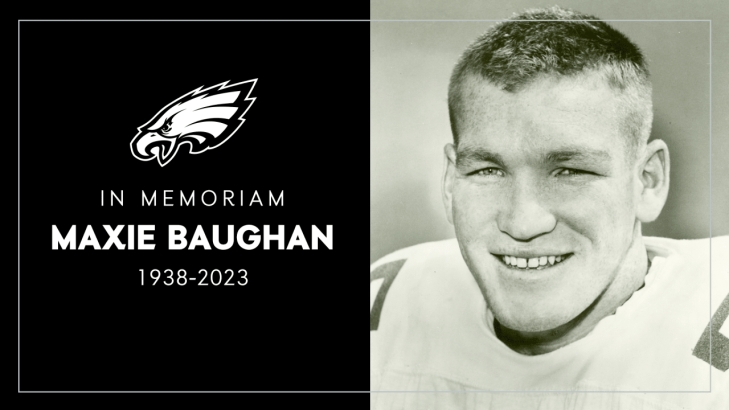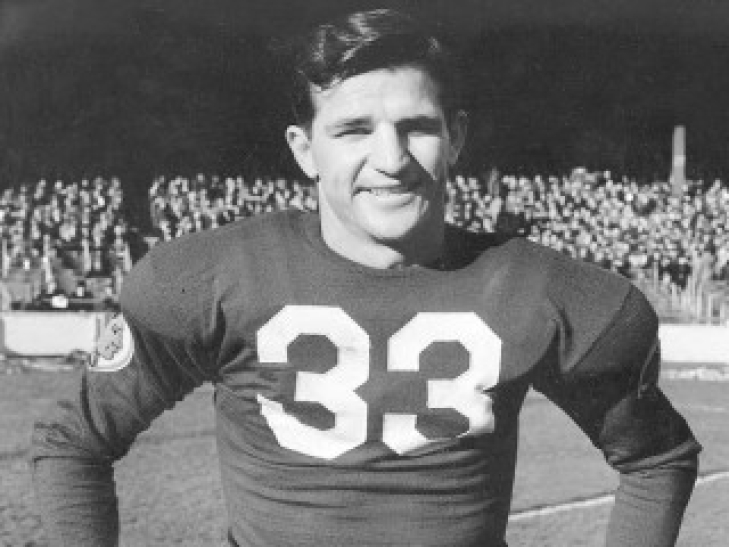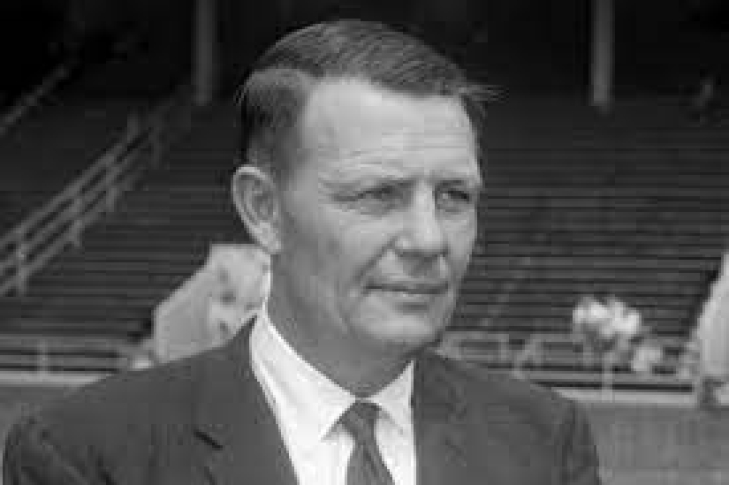
Committee Chairman
RIP: Maxie Baughan
Maxie Baughan, who was named as one of the 2024 Pro Football Hall of Fame Senior Finalists, passed away at the age of 85.
An All-American at Georgia Tech, Baughan was Philadelphia’s Second Round Pick in 1960. As a rookie, Baughan was a starting Linebacker for the Eagles 1960 NFL Championship Team. He was named to five Pro Bowls with Philadelphia, including a First Team All-Pro in 1964.
As the Eagles declined, Baughan sought greener pastures, and was traded to the Los Angeles Rams, where he played from 1966 to 1970 collecting four more Pro Bowls to give him nine in total. He retired after the 1970 Season, becoming a coach, though was talked into a brief comeback by Redskins Coach, George Allen in 1974. He retired for good afterward.
Baughan is a member of the Philadelphia Eagles Hall of Fame and the College Football Hall of Fame.
In our latest Notinhalloffame.com ranking of those to consider for the Pro Football Hall of Fame, Baughan was ranked #14.
We here at Notinhalloffame.com would like to extend our condolences to the fans, friends and family of Maxie Baughan.
The Pro Football Hall of Fame Revisited Project: 1947 FINAL VOTE
Here we are! Again!!
If you have been following our Pro Football Hall of Fame Revisited Project, you know that we have asked the rhetorical question…what if the PFHOF began in January of 1946?
After soliciting and obtaining a passionate group of football fans and historians, we sent out a ballot for a Preliminary Vote, which we asked each voter to give us 25 names as their semi-finalists, and 5 in the Senior Pool. Following that, we asked the group to vote for their 15 Finalists in the Modern Era, and 3 in the Senior Category. The final stage was to vote for their 5 Modern Era inductees and 1 Senior inductee.
This is the result of the second official class;
Below, are the final results of this project based on 30 votes:
This is for the “Modern Era”
*Bold indicates they have been elected to the Pro Football Hall of Fame Revisited Class of 1946:
|
Player |
Year of Eligibility |
Vote Total |
|
Ernie Nevers FB |
11 |
25 |
|
Cal Hubbard T-E-DE-G |
6 |
19 |
|
Dutch Clark TB |
4 |
14 |
|
Ed Healey T-G-E |
16 |
12 |
|
Paddy Driscoll HB-QB-TB-BB |
13 |
12 |
|
Pete Henry T |
14 |
11 |
|
George Trafton C |
11 |
10 |
|
Johnny Blood TB-HB-WB-BB-DB |
4 |
10 |
|
Guy Chamberlin E-WB |
15 |
9 |
|
Benny Friedman TB-DB |
8 |
9 |
|
Duke Slater T |
11 |
7 |
|
Lavvie Dilweg E |
8 |
6 |
|
Clark Hinkle FB-LB-HB-DB |
1 |
6 |
|
Joe Guyon WB-TB-BB-FB |
15 |
4 |
|
Link Lyman T |
8 |
1 |
This is for the “Senior Era”
*Bold indicates they have been elected to the Pro Football Hall of Fame Revisited Class of 1946:
|
John Brallier |
N/A |
14 |
|
Charles Follis |
N/A |
12 |
|
Blondy Wallace |
N/A |
5 |
About the 1947 Inductees:
Ernie Nevers FB, DUL 1926-27, CRD 1929-31: Inducted in 1947 on the 2nd Ballot (technically his 11th year of eligibility). Was inducted into the actual Pro Football Hall of Fame in 1963.
Stanford Head Coach, Pop Warner, called Ernie Nevers a “player without a fault” and if that does not say it all, we don’t know what does. Following his career at Stanford, Nevers first played professional football for a team in Jacksonville, Florida, which he left to play professional baseball for the St. Louis Browns. When the Browns season ended, the dual-sport star returned to the gridiron for the Duluth Eskimos, where the team played 29 Games (14 official in the NFL) and Nevers allegedly played every minute of every game. Following Duluth’s poor 1927 Season (though Nevers was outstanding), Nevers did not play football in 1928, but re-emerged in 1929 with the Chicago Cardinals. With the Cardinals, Nevers set a record by scoring all 40 Points in Chicago’s 40-6 win over the cross-town Bears. The game before, he scored all 19 of his team’s Points! Nevers was the ultimate Fullback for his day, and in all five seasons he played, was named a First Team All-Pro, and he was also a 1920s All-Decade Selection.
Cal Hubbard T-E-DE-G, NYG 1927-28 & 1936, GNB 1929-33 & 1935 & PIT 1936: Inducted in 1947 on the 2nd Ballot (technically his 6th year of eligibility). Was inducted into the actual Pro Football Hall of Fame in 1963.
Weighing in at 250 Pounds, Cal Hubbard was a large man for the 1920s and 1930s, and was also incredibly fast and strong. Considered one of the best Linemen of his day, Hubbard won four NFL Championships (one with New York and three with Green Bay). A First Team All-Pro on four occasions, he was named the NFL’s All-Time Offensive Tackle in 1969.
Dutch Clark TB, PRT 1931-32 & DET 1934-38: Inducted in 1946 on the 2nd Ballot (technically his 4th year of eligibility). Was inducted into the actual Pro Football Hall of Fame in 1963.
Dutch Clark had an unusual trip to the Pro Football Hall of Fame, one that reflects the unique nature of the game in the 1930s. Clark was an All-American at Colorado College, and while he graduated in 1929, he didn’t play professional until 1931, playing two years with the Portsmouth Spartans as their offensive leader. Throwing, rushing and kicking, Clark was an automatic leader, but he opted out, taking the Head Coaching job at the Colorado School of Mines. That lasted a year, and Clark returned to the Spartans, who were now the Detroit Lions. Clark led Detroit to the 1935 NFL Championship, and was a six-time First Team All-Pro. A greater gridiron leader, the Lions could not have found in the 30s.
Ed Healey T-G-E, RII 1920-22 & CHI 1922-27: Inducted in 1947 on the 2nd Ballot (technically his 16th year of eligibility). Was inducted into the actual Pro Football Hall of Fame in 1964.
From Dartmouth, Ed Healey began his pro career for the Rock Island Independents. In a 1922 game against the Chicago Bears, the Tackle was so good, that Bears Player/Coach/Owner, George Halas, bought the contract of Healey, marking the first time a player was sold in the NFL. Healey was a First Team All-Pro for Chicago in his first four years as a Bear, and was considered the most versatile Tackle in the game.
Paddy Driscoll HB-QB-TB-BB, CHI 1920 & 1926-29, & CRD 1921-25: Inducted in 1947 on the 1st Ballot (technically his 13th year of eligibility). Was inducted into the actual Pro Football Hall of Fame in 2005.
John “Paddy” Driscoll was a “Mr. Everything” of sorts for the Chicago Cardinals, the team that bid for, and won his services when they became a charter member of the NFL in 1920. Driscoll was a small man (5’ 11” and 160) but did it all on both sides of the ball, and as their kicker. An expert rusher and passer (for his era), Driscoll once dropkicked four Field Goals in a game and had a 27 Point Game in 1923. A three-time First Team All-Pro with the Cardinals, he led them to a Championship in 1925. Driscoll then joined the rival, Chicago Bears, in 1926, where he was named to two more First Team All-Pros.
John Brallier: Inducted in 1947 on the 2nd Senior Ballot. Was never inducted into the Pro Football Hall of Fame.
A valid criticism of the PFHOF is that it has taken little account to those who laid professional football’s groundwork. This was rectified last week with the induction of Pudge Heffelfinger and now this “year” with John Brallier. The first openly paid football player when he was given $10 in 1895 to play for the Latrobe Athletic Association at age 17, Brallier played for many other teams before he went to college. He returned to Latrobe in 1902 as a player/coach and led his squad to four undefeated seasons.
From Slot Machines to Skill-Based Gaming: The Diverse Landscape of Casino Games
From chance-based slot machines to skill-based poker and live dealer products, the gambling business has accepted a greater granular variety that is focused on convenience, innovation, and culture-specific enjoyment. Now we are facing the age of iGaming, completely diversified by brands like Vulcanvegas, when all punters can find some titles that entirely meet their gaming demands.
The concept of wagering money on rolling dice and playing cards to win something of a bigger value dates back to times immemorial, or at least as far as 100 A.D. in human history.
Every country has seen some ado concerning gambling legalizations, laws, and liaisons.
Over the last two decades, however, the advancement of gambling technology and the introduction of Internet casinos have inspired a swift whirlwind of transformation like never before. Today, online casinos have moved the market down to earth and reached a diverse audience with the following features:
- More affordable gambling options enabling returns even with small wagers;
- The convenience of mobile gaming allowing the play-on-the-go option;
- Wide variety of games catering to more diverse target audiences;
- Dynamic multi-platform streaming from simulated “real casino” atmospheres;
- The diversity of secure payment gateways paving the way for more international transactions;
- High-profile gaming legislations and regulatory environments promoting secure and responsible gambling worldwide.
Earlier, gambling was more suited for a certain audience—the ethical playground of high-rollers and whales with larger-than-life gaming portfolios—but now, the low-roller is not clearly on the losing side. With all of these discoveries, this post delves into the broad terrain of gaming products, from traditional slot machines to skill-based varieties, scanning the rich diversity that characterizes the modern casino experience.
Slot Machine Evolution: From Mechanical Marvels to Thematic Fervour
Slot machines have been amusing us since the late 1800s when they were introduced as mechanical devices with a few simple functions. Nonetheless, they gradually became the focal attraction in casinos, luring players with their dynamic content, exciting themes and features, and the chance to win life-changing prizes.
Regardless of how complicated and dynamic the themes and in-game elements get, machines remain the easiest to understand, which is why these products attract both expert and rookie punters and have a cult fan base. With bets beginning at a small sum, it is still entirely about chance rather than dexterity and talent, with the "anyone can afford to win" factor.
Video Poker: Chance & Skill Combination
Video poker machines were a major sensation in the 1970s by combining the appeal of slot machines with the smart aspects of poker (which demand skill to win the game).
The premise that picking which cards to play affects the result of the game gives little space for talent, but with careful adjustment bets, one may avoid incurring a significant loss at the sacrifice of tenacity. Since expert players may boost their odds of winning, video poker machines offer higher payout rates and have grown in popularity.
Table Games: Balance Between Luck and Strategy
Way before the boom of slots, table games gained prominence in the casino industry. Unlike slots, titles like poker, blackjack, and baccarat are associated with combining skill and luck, letting players make strategic decisions that will affect the outcome.
The appeal of skill-based gambling lies in the social aspect and the excitement of outsmarting dealers or opponents. Players' capability of developing their skills and applying strategies over time adds an extra layer of excitement and engagement.
One of the most popular table games are:
➔ Poker - Often hailed as the "big daddy" of casino games, poker demands more skill from players than any other game of its kind. It allows gamblers to play against each other instead of facing off against the dealer or the house. Those who relish the social aspect of gambling, possess a competitive spirit, and believe in their ability to read people are naturally drawn to this casino staple;
➔ Blackjack - This title keeps players involved and attentive by striking a delicate mix between luck and ability. You compete against the dealer, who has a tiny edge, and your decisions are based on math to enhance your chances of winning.
The Technological Revolution of Casinos: From Land-Based to Online Platforms
The current level of development has brought considerable changes to the industry through the latest technology. Innovations like online casinos, mobile betting, virtual reality gaming, and blockchain-based platforms have totally transformed the gambling experience, making it convenient, customer-focused, secure, and immersive. Reputable casinos have embraced these advancements to provide players with an unmatched and safe gambling experience, catering to the preferences of a digital-savvy audience.
Skill-Based Gaming: A Revolution in Casino Entertainment
In addition to conventional casino games, casinos sometimes explore various adaptations of famous niches to draw a broader audience. Among the intriguing developments in casino gaming over recent years are skill-based slots. Game developers design diverse scenarios based on various identifiers, rewarding skilled players with increased payouts. This stands as the fundamental contrast between skill-based and luck-based games, and at times, each might complement the other.
Buddy Parker named the Coaches/Contributor Finalist for the 2023 PFHOF Class
We are in the 2023 National Football League pre-season, and as always it coincides with the Pro Football Hall of Fame announcements of their Senior and Coach/Contributor Finalist. Today, the latter was announced, and it was former Detroit Lions and Pittsburgh Steelers Head Coach, Buddy Parker.
Parker was Detroit’s Head Coach from 1951 to 1955, where he led them to two NFL Championships. He was also Pittsburgh’s Head Coach from 1957 to 1964 and had an overall record of 104-75-9.
This does not mean that Parker is a slam dunk for induction, as he will be put forth towards the 50-person Selection Committee, but history indicates the will likely be elected.
Those who were Semi-Finalists, but did not make the cut were Tom Coughlin, Mike Holmgren, Frank “Bucko” Kilroy, Robert Kraft, Dan Reeves, Art Rooney Jr., Marty Schottenheimer, Mike Shanahan, Clark Shaughnessy, Lloyd Wells and John Wooten





